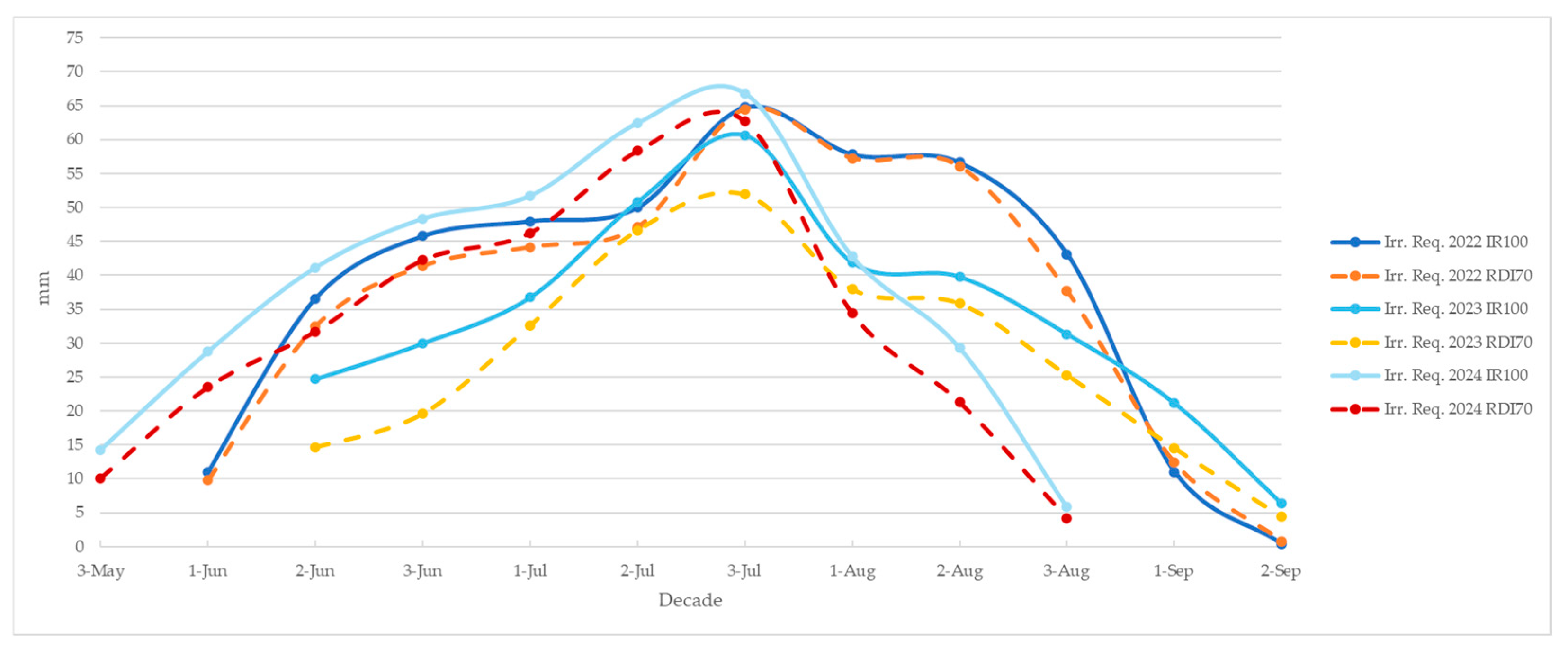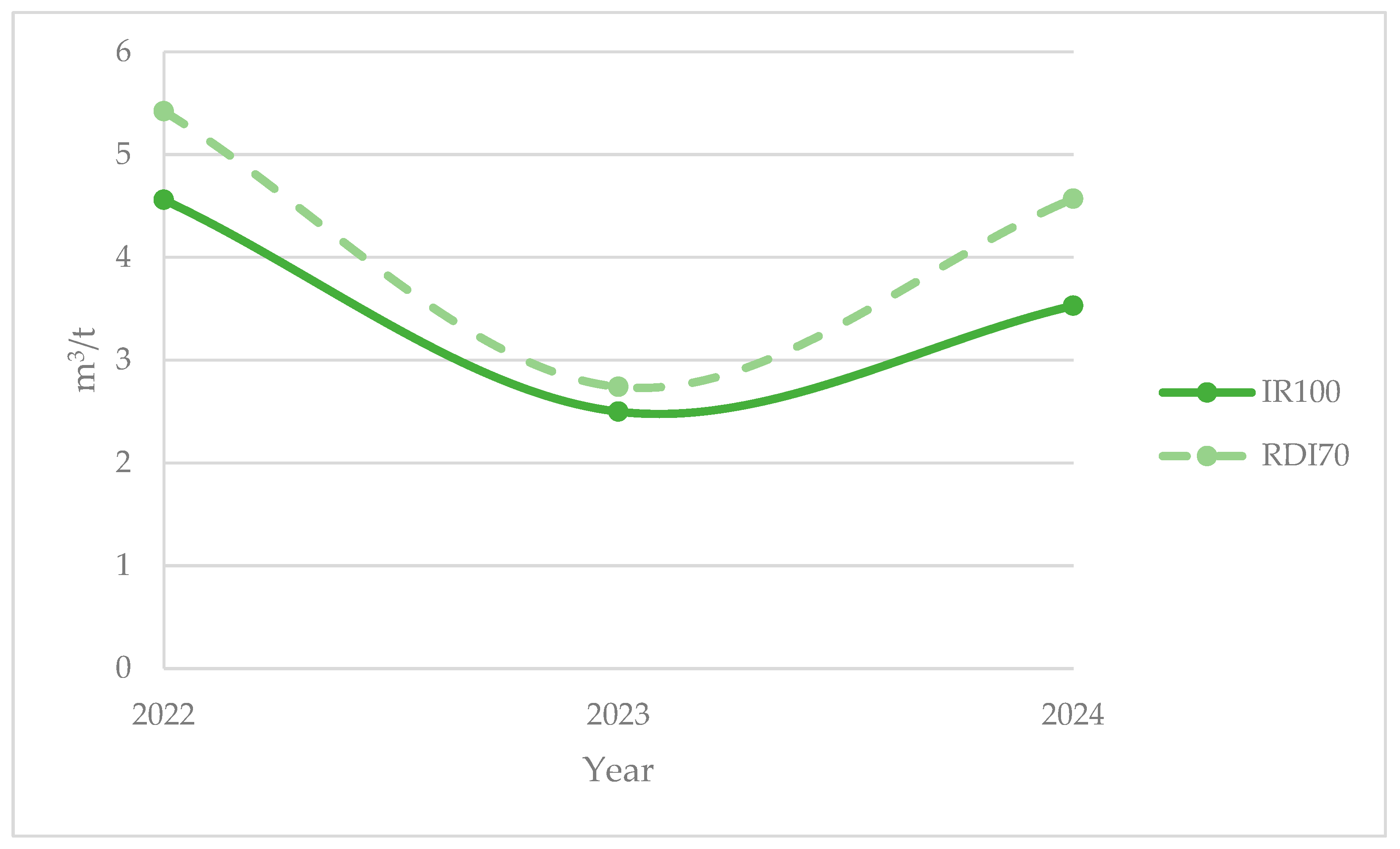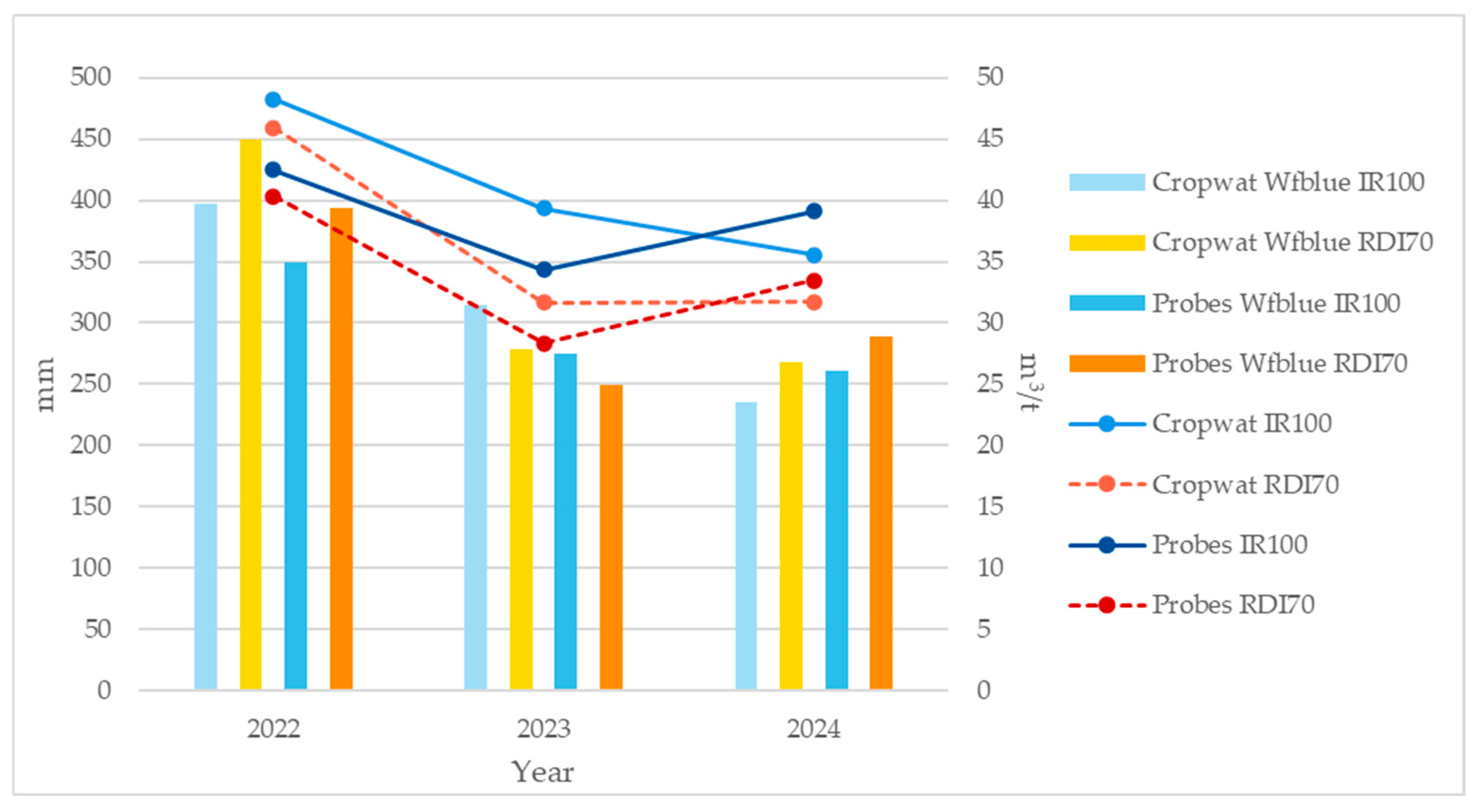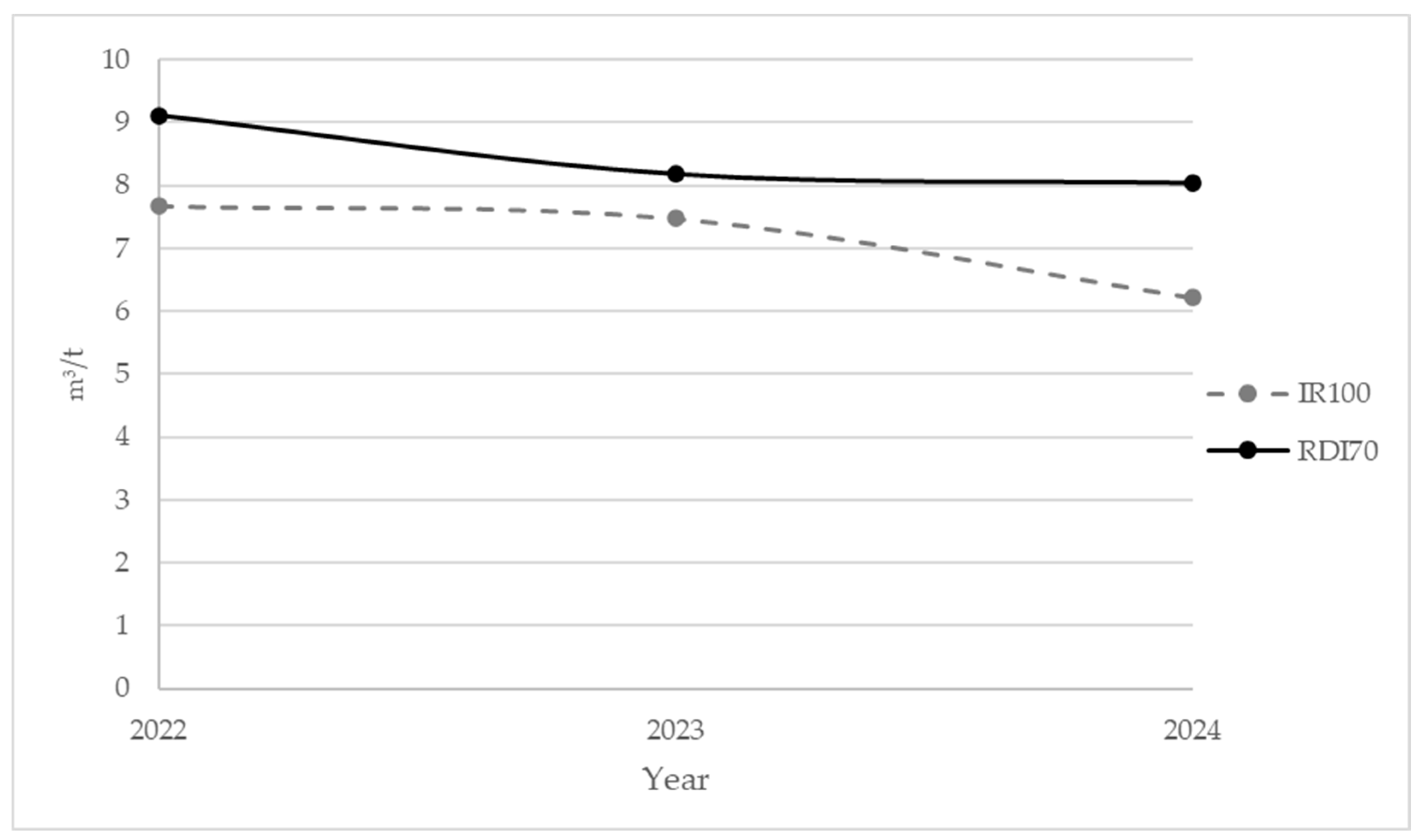Crop Water Requirement Estimated with Data-Driven Models Improves the Reliability of CROPWAT 8.0 and the Water Footprint of Processing Tomato Grown in a Hot-Arid Environment
Abstract
1. Introduction
2. Materials and Methods
2.1. Exsperimental Sites
2.2. Plant Material and Crop Management
2.3. Meteorological Data
2.4. Determination of Soil Hydrological Properties
2.5. Irrigation Management
2.6. Restoration of Crop Water Requirement via Probes
2.7. CROPWAT 8.0 Model
2.7.1. Irrigation Based on the CROPWAT 8.0 Model
2.7.2. Input Data Related to Climate
2.7.3. Input Data Related to Crop and Soil
2.8. Water Footprint
3. Results
3.1. Estimation of CWR Using the CROPWAT 8.0
3.2. Estimation of CWR Using Data Collected from Probes
3.3. Environmental Impact: Water Footprint
3.3.1. Water Footprint Green (WFgreen)
3.3.2. Water Footprint Blue (WFblue)
3.3.3. Water Footprint Grey (WFgrey)
3.3.4. Water Footprint Total (WFtotal)
4. Discussion
4.1. Importance of Soil Water Content Monitoring for Irrigation Management
4.2. Comparing CROPWAT and Probe-Based Estimations of Crop Water Requirements
4.3. Comparing CROPWAT and Probe-Based Estimations of Water Footprint Analysis
4.4. Implications for Water Footprint and Sustainable Management in Processing Tomato Cultivation
5. Conclusions
Supplementary Materials
Author Contributions
Funding
Data Availability Statement
Acknowledgments
Conflicts of Interest
References
- Food and Agriculture Organization Corporate Statistical Database. Available online: http://www.fao.org/faostat/en/#data (accessed on 1 February 2025).
- National Association of Vegetable Food Preserving Industries. Available online: https://anicav.it/i-prodotti/pomodoro/ (accessed on 26 January 2025).
- Iacuzzi, N.; Tuttolomondo, T.; Farruggia, D.; Tortorici, N.; Alaimo, F.; De Santis, D.; Rossini, F.; Di Miceli, G. A Two-Year Evaluation of Biostimulant Effects on Yield and Quality Parameters of Tomato Landrace ‘Pizzutello Delle Valli Ericine’ Cultivated Without Irrigation. J. Sustain. Agric. Environ. 2024, 3, sae2.70028. [Google Scholar] [CrossRef]
- Intergovernmental Panel on Climate Change (IPCC). Climate Change 2021—The Physical Science Basis: Working Group I Contribution to the Sixth Assessment Report of the Intergovernmental Panel on Climate Change; Cambridge University Press: Cambridge, UK, 2023; Available online: https://www.ipcc.ch/report/ar6/wg1/ (accessed on 21 May 2025).
- Wu, B.; Tian, F.; Zhang, M.; Piao, S.; Zeng, H.; Zhu, W.; Liu, J.; Elnashar, A.; Lu, Y. Quantifying Global Agricultural Water Appropriation with Data Derived from Earth Observations. J. Clean. Prod. 2022, 358, 131891. [Google Scholar] [CrossRef]
- Perelli, C.; Branca, G.; Corbari, C.; Mancini, M. Physical and Economic Water Productivity in Agriculture between Traditional and Water-Saving Irrigation Systems: A Case Study in Southern Italy. Sustainability 2024, 16, 4971. [Google Scholar] [CrossRef]
- Chen, X.; Dong, H.; Qi, Z.; Gui, D.; Ma, L.; Thorp, K.R.; Malone, R.; Wu, H.; Liu, B.; Feng, S. Potential Deficit Irrigation Adaptation Strategies under Climate Change for Sustaining Cotton Production in Hyper–Arid Areas. Agric. Water Manag. 2025, 312, 109417. [Google Scholar] [CrossRef]
- Añibarro-Ortega, M.; Pereira, A.; Pinela, J.; Liava, V.; Chaski, C.; Alexopoulos, A.A.; Barros, L.; Petropoulos, S.A. Enhancing Tomato Growth and Quality Under Deficit Irrigation with Silicon Application. Agronomy 2025, 15, 682. [Google Scholar] [CrossRef]
- Belkher, S.; Latrech, B.; Bekri, W.; Markwordt, F.; Rahim, M.A.; Dupont, C.; Ben Abdallah, M.A.; Daghari, H.; Rezig, M. Deficit Irrigation and an IoT-Based System for Improving Yield and Water Use Efficiency of Winter Wheat Grown Under Semi-Arid Conditions. Agronomy 2025, 15, 157. [Google Scholar] [CrossRef]
- Katerji, N.; Mastrorilli, M.; Rana, G. Water Use Efficiency of Crops Cultivated in the Mediterranean Region: Review and Analysis. Eur. J. Agron. 2008, 28, 493–507. [Google Scholar] [CrossRef]
- Burato, A.; Fusco, G.M.; Pentangelo, A.; Nicastro, R.; Modugno, A.F.; Scotto Di Covella, F.; Ronga, D.; Carillo, P.; Campi, P.; Parisi, M. Regulated Deficit Irrigation to Boost Processing Tomato Sustainability and Fruit Quality. Sustainability 2024, 16, 3798. [Google Scholar] [CrossRef]
- Martí, R.; Valcárcel, M.; Leiva-Brondo, M.; Lahoz, I.; Campillo, C.; Roselló, S.; Cebolla-Cornejo, J. Influence of Controlled Deficit Irrigation on Tomato Functional Value. Food Chem. 2018, 252, 250–257. [Google Scholar] [CrossRef]
- Patanè, C.; Cosentino, S.L. Effects of Soil Water Deficit on Yield and Quality of Processing Tomato under a Mediterranean Climate. Agric. Water Manag. 2010, 97, 131–138. [Google Scholar] [CrossRef]
- Jin, N.; Zhang, D.; Jin, L.; Wang, S.; Yang, X.; Lei, Y.; Meng, X.; Xu, Z.; Sun, J.; Lyu, J.; et al. Controlling Water Deficiency as an Abiotic Stress Factor to Improve Tomato Nutritional and Flavour Quality. Food Chem. X 2023, 19, 100756. [Google Scholar] [CrossRef] [PubMed]
- Giuliani, M.M.; Carucci, F.; Nardella, E.; Francavilla, M.; Ricciardi, L.; Lotti, C.; Gatta, G. Combined Effects of Deficit Irrigation and Strobilurin Application on Gas Exchange, Yield and Water Use Efficiency in Tomato (Solanum lycopersicum L.). Sci. Hortic. 2018, 233, 149–158. [Google Scholar] [CrossRef]
- Mukherjee, S.; Dash, P.K.; Das, D.; Das, S. Growth, Yield and Water Productivity of Tomato as Influenced by Deficit Irrigation Water Management. Environ. Process. 2023, 10, 10. [Google Scholar] [CrossRef]
- Lovelli, S.; Potenza, G.; Castronuovo, D.; Perniola, M.; Candido, V. Yield, Quality and Water Use Efficiency of Processing Tomatoes Produced Under Different Irrigation Regimes in Mediterranean Environment. Ital. J. Agron. 2017, 12, 795. [Google Scholar] [CrossRef]
- Ferrarezi, R.S.; Van Iersel, M.W.; Testezlaf, R. Monitoring and Controlling Ebb-and-Flow Subirrigation with Soil Moisture Sensors. HortScience 2015, 50, 447–453. [Google Scholar] [CrossRef]
- Allen, R.G. (Ed.) Crop Evapotranspiration: Guidelines for Computing Crop Water Requirements; FAO Irrigation and Drainage Paper; Food and Agriculture Organization of the United Nations: Rome, Italy, 2000; ISBN 978-92-5-104219-9. [Google Scholar]
- De Oliveira, H.F.E.; De Moura Campos, H.; Mesquita, M.; Machado, R.L.; Vale, L.S.R.; Siqueira, A.P.S.; Ferrarezi, R.S. Horticultural Performance of Greenhouse Cherry Tomatoes Irrigated Automatically Based on Soil Moisture Sensor Readings. Water 2021, 13, 2662. [Google Scholar] [CrossRef]
- Pereira, L.S.; Paredes, P.; Jovanovic, N. Soil Water Balance Models for Determining Crop Water and Irrigation Requirements and Irrigation Scheduling Focusing on the FAO56 Method and the Dual Kc Approach. Agric. Water Manag. 2020, 241, 106357. [Google Scholar] [CrossRef]
- Smith, M. CROPWAT: A Computer Program for Irrigation Planning and Management; FAO Irrigation and Drainage Paper; Ver. 5.7; Food and Agriculture Organization of the United Nations: Rome, Italy, 1992; ISBN 978-92-5-103106-3. [Google Scholar]
- Etissa, E.; Dechassa, N. Estimation of Yield Response (Ky) and Validation of CropWat for Tomato under Different Irrigation Regimes. Irrig. Drain. Syst. Eng. 2016, 5, 1–6. [Google Scholar] [CrossRef]
- Gebremariam, F.T.; Habtu, S.; Yazew, E.; Teklu, B. The Water Footprint of Irrigation-Supplemented Cotton and Mung-Bean Crops in Northern Ethiopia. Heliyon 2021, 7, e06822. [Google Scholar] [CrossRef]
- Constantin, D.M.; Mincu, F.I.; Diaconu, D.C.; Burada, C.D.; Băltățeanu, E. Water Management in Wheat Farming in Romania: Simulating the Irrigation Requirements with the CROPWAT Model. Agronomy 2024, 15, 61. [Google Scholar] [CrossRef]
- Champaneri, D.D.; Desai, K.D.; Ahlawat, T.R.; Shrivastava, A.; Pampaniya, N.K. Assessment of CROPWAT 8.0 Model Accuracy under Deficit Irrigation Scheduling: A Sustainable Path toward Smart Water Supply. Water Supply 2024, 24, 3423–3437. [Google Scholar] [CrossRef]
- Egea, G.; Castro-Valdecantos, P.; Gómez-Durán, E.; Munuera, T.; Domínguez-Niño, J.M.; Nortes, P.A. Impact of Irrigation Management Decisions on the Water Footprint of Processing Tomatoes in Southern Spain. Agronomy 2024, 14, 1863. [Google Scholar] [CrossRef]
- Salomone, R. Pathways to Environmental Sustainability: Methodologies and Experiences; Springer: Cham, Switzerland, 2014; ISBN 978-3-319-03826-1. [Google Scholar]
- Ridoutt, B.G.; Pfister, S. A Revised Approach to Water Footprinting to Make Transparent the Impacts of Consumption and Production on Global Freshwater Scarcity. Glob. Environ. Change 2010, 20, 113–120. [Google Scholar] [CrossRef]
- Hoekstra, A.Y.; Chapagain, A.K.; Aldaya, M.M.; Mekonnen, M.M. The Water Footprint Assessment Manual: Setting the Global Standard; Earthscan from Routledge: London, UK; Washington, DC, USA, 2011; ISBN 978-1-84971-279-8. [Google Scholar]
- Payen, S.; Basset-Mens, C.; Perret, S. LCA of Local and Imported Tomato: An Energy and Water Trade-Off. J. Clean. Prod. 2015, 87, 139–148. [Google Scholar] [CrossRef]
- Chico, D. The Water Footprint and Virtual Water Exports of Spanish Tomatoes; Fundación Marcelino Botín: Santander, Spain, 2010; ISBN 978-84-96655-80-5. [Google Scholar]
- Vinci, G.; Campana, P.; Gobbi, L.; Prencipe, S.A.; Ruggeri, M. Integrated Evaluation of Sustainability and Quality of Italian Tomato Cultivars Grown Under Irrigated and Non-Irrigated Systems. Agriculture 2025, 15, 416. [Google Scholar] [CrossRef]
- Pathak, T.B.; Stoddard, C.S. Climate Change Effects on the Processing Tomato Growing Season in California Using Growing Degree Day Model. Model. Earth Syst. Environ. 2018, 4, 765–775. [Google Scholar] [CrossRef]
- Dane, J.H.; Topp, G.C.; Campbell, G.S. (Eds.) Methods of Soil Analysis: Part 4: Physical Methods; Number 5 in the Soil Science Society of America Book Series; Soil Science Society of America: Madison, WS, USA, 2002; ISBN 978-0-89118-893-3. [Google Scholar]
- CROPWAT Software, FAO, Land and Water Division. Available online: http://www.fao.org/land-water/databases-and-software/cropwat/en/ (accessed on 20 October 2024).
- Savva, A.P.; Frenken, K. Irrigation Manual: Planning, Development, Monitoring and Evaluation of Irrigated Agriculture with Farmer Participation; Food and Agriculture Organization of the United Naitons (FAO), Sub-Regional Office for East and Southern Africa (SAFR): Harare, Zimbabwe, 2001; ISBN 978-0-7974-2318-3. [Google Scholar]
- Ewaid, S.H.; Abed, S.A.; Al-Ansari, N. Crop Water Requirements and Irrigation Schedules for Some Major Crops in Southern Iraq. Water 2019, 11, 756. [Google Scholar] [CrossRef]
- Muratoglu, A.; Bilgen, G.K.; Angin, I.; Kodal, S. Performance Analyses of Effective Rainfall Estimation Methods for Accurate Quantification of Agricultural Water Footprint. Water Res. 2023, 238, 120011. [Google Scholar] [CrossRef]
- EN ISO 14046; Environmental Management Water Footprint Principles, Requirements and Guidelines. International Organization for Standardization (ISO): Geneva, Switzerland, 2016. Available online: https://www.iso.org/standard/43263.html (accessed on 23 February 2025).
- Pellegrini, G.; Ingrao, C.; Camposeo, S.; Tricase, C.; Contò, F.; Huisingh, D. Application of Water Footprint to Olive Growing Systems in the Apulia Region: A Comparative Assessment. J. Clean. Prod. 2016, 112, 2407–2418. [Google Scholar] [CrossRef]
- Mekonnen, M.M.; Hoekstra, A.Y. The Green, Blue and Grey Water Footprint of Crops and Derived Crop Products. Hydrol. Earth Syst. Sci. 2011, 15, 1577–1600. [Google Scholar] [CrossRef]
- Bouregaa, T.; Chetioui, C. Assessment of Climate Change Impact on Wheat Water Demand and Yield in Setif, Algeria. Water Conserv. Sci. Eng. 2025, 10, 1. [Google Scholar] [CrossRef]
- Gabr, M.E. Impact of Climatic Changes on Future Irrigation Water Requirement in the Middle East and North Africa’s Region: A Case Study of Upper Egypt. Appl. Water Sci. 2023, 13, 158. [Google Scholar] [CrossRef]
- N’guessan, K.J.-Y.; Adahi, B.; Konan-Waidhet, A.-B.; Masayoshi, S.; Assidjo, N.E. Assessment of Climate Change Impact on Water Requirement and Rice Productivity. Rice Sci. 2023, 30, 276–293. [Google Scholar] [CrossRef]
- Ronghang, R.; Patle, G.T.; Vashisht, A.K.; Kusre, B.C.; Jhajharia, D.; Kumar, M. Crop Water Demand Estimation and Irrigation Scheduling for Sustainable Water Management and Crop Planning in Selected Watersheds of Meghalaya, India. Water Environ. Res. 2025, 97, e70038. [Google Scholar] [CrossRef]
- Kc, B.; Schultz, B.; Mohssen, M.; Chau, H.W.; Pandey, V.P.; Prasad, K.; Anthony, P. Assessing Effective Pasture Root Depth for Irrigation Scheduling by Water Balance and Soil Moisture Monitoring. Irrig. Drain. 2022, 71, 971–979. [Google Scholar] [CrossRef]
- Kanzari, S.; Daghari, I.; Šimůnek, J.; Younes, A.; Ilahy, R.; Ben Mariem, S.; Rezig, M.; Ben Nouna, B.; Bahrouni, H.; Ben Abdallah, M.A. Simulation of Water and Salt Dynamics in the Soil Profile in the Semi-Arid Region of Tunisia—Evaluation of the Irrigation Method for a Tomato Crop. Water 2020, 12, 1594. [Google Scholar] [CrossRef]
- Bayisa, G.D.; Ayana, M.; Mekonnen, B.; Hordofa, T.; Dinka, M.O. Drainage Lysimeter Based Measurement of Water Requirement and Crop Coefficient of Bread Wheat under Semi-Arid Climate of Melkassa, Ethiopia. Heliyon 2024, 10, e36969. [Google Scholar] [CrossRef] [PubMed]
- Kebede, N.; Ayana, M.; Mekonnen, B. Quantification of Onion (Allium cepa L.) Evapotranspiration and Crop Coefficient via Weighable Lysimeter under Semi-Arid Climate of Melkasa, Ethiopia. Heliyon 2025, 11, e42566. [Google Scholar] [CrossRef] [PubMed]
- Loos, C.; Gayler, S.; Priesack, E. Assessment of Water Balance Simulations for Large-Scale Weighing Lysimeters. J. Hydrol. 2007, 335, 259–270. [Google Scholar] [CrossRef]
- Wu, Y.; Yan, S.; Fan, J.; Zhang, F.; Zhao, W.; Zheng, J.; Guo, J.; Xiang, Y.; Wu, L. Combined Effects of Irrigation Level and Fertilization Practice on Yield, Economic Benefit and Water-Nitrogen Use Efficiency of Drip-Irrigated Greenhouse Tomato. Agric. Water Manag. 2022, 262, 107401. [Google Scholar] [CrossRef]
- Balendonck, J.; Hemming, J.; van Tuijl, B.A.J.; Incrocci, L.; Pardossi, A.; Marzialetti, P. Sensors and wireless sensor networks for irrigation management under deficit conditions (FLOW-AID). Presented at the AgEng2008, International Conference on Agricultural Engineering, Crete, Greece, 23–25 June 2008. [Google Scholar]
- Braaten, M.; Ireson, A. A Critical Assessment of Geological Weighing Lysimeters: Part 1—Monitoring Field Scale Soil Moisture Storage. Hydrol. Process. 2025, 39, e70042. [Google Scholar] [CrossRef]
- Reta, B.G.; Hatiye, S.D.; Finsa, M.M. Crop Water Requirement and Irrigation Scheduling under Climate Change Scenario, and Optimal Cropland Allocation in Lower Kulfo Catchment. Heliyon 2024, 10, e31332. [Google Scholar] [CrossRef]
- Garofalo, P.; Riccardi, M.; Di Tommasi, P.; Tedeschi, A.; Rinaldi, M.; De Lorenzi, F. AquaCrop Model to Optimize Water Supply for a Sustainable Processing Tomato Cultivation in the Mediterranean Area: A Multi-Objective Approach. Agric. Syst. 2025, 223, 104198. [Google Scholar] [CrossRef]
- Khaskhoussy, K.; Zarai, B.; Zouari, M.; Nasr, Z.; Hachicha, M. The Impact of Climate Change on Tomato Water Footprint under Irrigation with Saline Water in a Kairouan Irrigated Area (Tunisia Center). Horticulturae 2024, 10, 1267. [Google Scholar] [CrossRef]
- Aldaya, M.M.; Hoekstra, A.Y. The Water Needed for Italians to Eat Pasta and Pizza. Agric. Syst. 2010, 103, 351–360. [Google Scholar] [CrossRef]
- Evangelou, E.; Tsadilas, C.; Tserlikakis, N.; Tsitouras, A.; Kyritsis, A. Water Footprint of Industrial Tomato Cultivations in the Pinios River Basin: Soil Properties Interactions. Water 2016, 8, 515. [Google Scholar] [CrossRef]






| Parameters | Unit of Measurement | Soil 2022 | Soil 2023 | Soil 2024 |
|---|---|---|---|---|
| Sandy | % | 64 | 59 | 58 |
| Loam | % | 13 | 13 | 13 |
| Clay | % | 23 | 28 | 29 |
| N tot | g kg−1 | 1.3 | 1.14 | 2.0 |
| P2O5 | mg kg−1 | 21 | 36 | 10.3 |
| K2O | mg kg−1 | 136 | 211 | 103 |
| C organic | g kg−1 | 11.6 | 17.05 | 15.7 |
| Organic matter | % | 1.46 | 1.34 | 1.57 |
| Electrical conductivity | µS cm−1 | 189.3 | 233.4 | 729.6 |
| pH | 7.0 | 7.4 | 7.9 |
| Sites | Growing Season Length | |||||||
|---|---|---|---|---|---|---|---|---|
| DAT | GDD | |||||||
| Init | Deve | Mid | Late | Init | Deve | Mid | Late | |
| Carboj 2002 | 26 | 24 | 26 | 22 | 429.1 | 424.8 | 375.1 | 372.9 |
| Carboj 2023 | 26 | 19 | 27 | 22 | 377.3 | 346.1 | 437.1 | 341.6 |
| Buonfornello 2024 | 29 | 28 | 16 | 18 | 357.8 | 429.8 | 295.85 | 295.25 |
| Sites | θFC [m3 m−3] | θIP [m3 m−3] |
|---|---|---|
| Carboj 2022 IR100 | 0.257 | 0.226 |
| Carboj 2022 RDI70 | 0.257 | 0.226 |
| Carboj 2023 IR100 | 0.257 | 0.218 |
| Carboj 2023 RDI70 | 0.230 | 0.199 |
| Buonfornello 2024 IR100 | 0.337 | 0.308 |
| Buonfornello 2024 RDI70 | 0.337 | 0.186 |
Disclaimer/Publisher’s Note: The statements, opinions and data contained in all publications are solely those of the individual author(s) and contributor(s) and not of MDPI and/or the editor(s). MDPI and/or the editor(s) disclaim responsibility for any injury to people or property resulting from any ideas, methods, instructions or products referred to in the content. |
© 2025 by the authors. Licensee MDPI, Basel, Switzerland. This article is an open access article distributed under the terms and conditions of the Creative Commons Attribution (CC BY) license (https://creativecommons.org/licenses/by/4.0/).
Share and Cite
Iacuzzi, N.; Tortorici, N.; Mosca, C.; Bondì, C.; Sarno, M.; Tuttolomondo, T. Crop Water Requirement Estimated with Data-Driven Models Improves the Reliability of CROPWAT 8.0 and the Water Footprint of Processing Tomato Grown in a Hot-Arid Environment. Agronomy 2025, 15, 1533. https://doi.org/10.3390/agronomy15071533
Iacuzzi N, Tortorici N, Mosca C, Bondì C, Sarno M, Tuttolomondo T. Crop Water Requirement Estimated with Data-Driven Models Improves the Reliability of CROPWAT 8.0 and the Water Footprint of Processing Tomato Grown in a Hot-Arid Environment. Agronomy. 2025; 15(7):1533. https://doi.org/10.3390/agronomy15071533
Chicago/Turabian StyleIacuzzi, Nicolò, Noemi Tortorici, Carmelo Mosca, Cristina Bondì, Mauro Sarno, and Teresa Tuttolomondo. 2025. "Crop Water Requirement Estimated with Data-Driven Models Improves the Reliability of CROPWAT 8.0 and the Water Footprint of Processing Tomato Grown in a Hot-Arid Environment" Agronomy 15, no. 7: 1533. https://doi.org/10.3390/agronomy15071533
APA StyleIacuzzi, N., Tortorici, N., Mosca, C., Bondì, C., Sarno, M., & Tuttolomondo, T. (2025). Crop Water Requirement Estimated with Data-Driven Models Improves the Reliability of CROPWAT 8.0 and the Water Footprint of Processing Tomato Grown in a Hot-Arid Environment. Agronomy, 15(7), 1533. https://doi.org/10.3390/agronomy15071533








